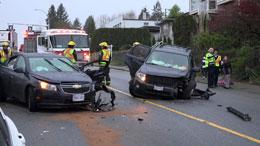Honour crash victims by learning from their loss

By Mike Morris
Minister of Public Safety and Solicitor General
B.C. has made considerable progress in reducing the human toll of road crashes. Still, this is cold comfort to victims’ families and friends, who know too well that we can do better.
In each of the past two years, approximately 290 people were killed on B.C.’s roads.
That’s about one of every seven people killed in crashes across Canada, and it’s a number that’s creeping up slightly after many years of a downward trend.
In the first week of November alone, we saw families lose loved ones in high-profile collisions in the Comox Valley, Kamloops, Hope, Burnaby and Richmond.
As we mark the National Day of Remembrance for Road Crash Victims, we must consider our individual roles and responsibilities in keeping each other safe, and recognize ongoing challenges. Crashes are preventable and we can save lives.
B.C.’s Motor Vehicle Act and Regulations specify hundreds of requirements for everyone from truck drivers to cyclists and pedestrians. Your particular mode of transport may not require a licence, but you still have responsibilities.
It’s vital for vulnerable road users to follow the rules of the road and be seen, be vigilant, and keep eye contact with those around them. The sad truth: while fatality numbers are falling for motorcyclists, they are rising for pedestrians and those travelling in other vehicles.
No matter how you get around, I’d encourage you to act on the major, known threats to your safety.
In B.C., over the last five years, police have cited distracted driving and inattention in more than one-third of road crash deaths.
Recognizing this as the single greatest growing threat to road safety, we introduced escalating penalties in June that start at $543 for a first offence – and new drivers remain banned from using any electronic device while driving. The B.C. government is considering even tougher measures if we don’t see results.
Nationally, the prevalence of drug-affected driving now rivals alcohol-affected driving. In B.C., the Immediate Roadside Prohibition (IRP) program, introduced in 2010, has cut alcohol-related traffic fatalities by half and we are maintaining that decrease.
But last year, we saw drug-affected fatalities increase significantly.
As Ottawa continues to develop its marijuana legalization approach, we are exploring ways to enhance deterrence and enforcement to keep drug-affected drivers off our roads.
Mandatory impoundment for excessive speeding came into effect concurrently with IRPs, giving the most egregious leadfoots more to think about.
But speed still contributes to one in three deaths on our roads. At this time of year especially, please keep in mind that the posted speed limit is the maximum under ideal conditions.
Early in my policing career, seatbelt use became mandatory. It took years to change behaviour among those who could remember buying new cars with no belts.
Yet even now, we still lose about four people every month who didn’t buckle up. It bears repeating: protect yourself, and use appropriate restraints like car seats and booster seats for smaller passengers.
By learning from fatal collisions, and by committing to follow the rules of the road, we can honour and remember those lost to road crashes. It’s up to each of us to prevent the preventable.









